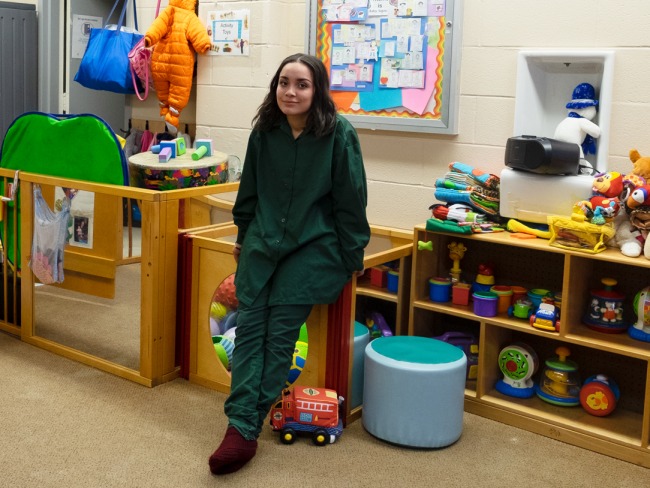Families and Mass Incarceration
In the United States mothers and fathers go to prison at troubling rates. One of every 12 American children, more than 5.7 million kids under age 18, have experienced parental incarceration at some point during their lives.
Related to: Collateral Consequences, Gender Justice
This article was originally published in Center for Advanced Studies in Child Welfare’s CW360°.
In the United States mothers and fathers go to prison at troubling rates. One of every 12 American children, more than 5.7 million kids under age 18, have experienced parental incarceration at some point during their lives (Child and Adolescent Health Measurement Initiative, 2016). About half of parents in prison lived with their children before their arrest or incarceration, and similar proportions of parents served as the primary source of financial support for their children (Child Welfare Information Gateway, 2015). While there should be consequences for breaking the law, this national phenomenon of mass parental incarceration is unique in the world and perpetuates a compounding dilemma.
The number of people in prisons and jails in the U.S. more than quadrupled from 1980 to 2015, and now total more than 2.2 million. Another 4.7 million people are under parole or probation supervision (Trends in U.S. Corrections, 2017). This growth is the result of changes in policy, not a dramatic rise in crime. The institution of long mandatory minimum sentences, the declining use of parole, and more punitive responses to substance use disorders helped to expand the prison population and the number of people entangled in the criminal justice system (Travis, Western, & Redburn (Eds.), 2014). These trends have continued even as crime rates have declined by nearly 50% after peaking in 1991 (Ghandnoosh, 2017).
Punitive policing and sentencing policies have had a disproportionate impact on communities of color. While people of color comprise 37% of the U.S. population, they represent 67% of the prison population. African Americans are more likely to be arrested, convicted, and incarcerated than similarly situated white Americans (Ghandnoosh, 2015). Among young African American males, one in three will spend some time incarcerated during his lifetime (Trends, 2017). While greater involvement in certain crimes explains some of the racial and ethnic disparity, issues of biased enforcement practices, inadequate legal defense resources, and structural racism are also key factors (Ghandnoosh, 2015).
Studies report numerous negative outcomes for children as a consequence of parental incarceration, ranging from depression and anxiety to aggression and delinquency depending on circumstances such as the child’s age and the length of a parent’s incarceration (Child Welfare Information Gateway, 2015). Additional evidence points to children’s extreme trauma resulting from the experience of parental arrest, which led the International Association of Chiefs of Police to develop and promote guidance for law enforcement agencies to improve interactions with children of arrested parents (International Association of Chiefs of Police, 2014). Author Nell Bernstein (2007) describes her research on the topic this way:
With appalling regularity, young people describe being left to fend for themselves in empty apartments for weeks or even months in the wake of a parent’s arrest. In most cases, these children were not present when their parent was arrested; they simply came home from school to find their parent gone and were left to draw their own conclusions – not to mention cook their own dinner. But some told of watching police handcuff and remove a parent—the only adult in the house—and simply leave them behind (p.14).
This kind of event can color a child’s perspective on policing and authority for a lifetime.
While there should be consequences for breaking the law, this national phenomenon of mass parental incarceration is unique in the world and perpetuates a compounding dilemma.
Once home, the burden of incarceration and criminal justice involvement continues for families. Federal and state laws create obstacles to securing employment, housing, financial assistance such as food stamps and Temporary Assistance for Needy Families, voting, and family reunification (Meyers, this issue). These collateral consequences complicate the reentry process and diminish the likelihood of successful reintegration. Moreover, the stress of repairing frayed relationships with families and children after a prolonged absence, or enduring the termination of parental rights, can exacerbate the challenges of reentry. Indeed, high rates of recidivism – over three-quarters of released prisoners are arrested for a new crime within five years – indicate that these transitions are often unsuccessful (Durose, Cooper, & Snyder, 2014).
The stark outcomes from mass incarceration signal a critical need for more robust interventions and accommodations for people entangled in the criminal justice system and their families. Reforms should:
- Reduce the length of incarceration and expand alternative sentencing options that do not require incarceration and separation from dependents.
- Invest in vulnerable communities to expand educational and employment opportunities for youth and adults and ensure access to quality medical, mental health, and substance use disorder services to address the root causes of crime.
- Protect children from the trauma of mass incarceration by training social workers, police, court personnel, and caregivers on best practices for aiding children with incarcerated parents and by offering parents the tools and support they need to better address their children’s needs.
- Eliminate arbitrary legal restrictions for people with criminal records that create obstacles to successful reintegration and increase investments in reentry services, including employment training, education, and drug treatment.



